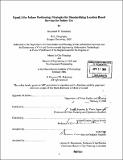OpenLS for indoor positioning : strategies for standardizing location based services for indoor use
Author(s)
Kolodziej, Krzysztof W., 1978-
DownloadFull printable version (39.01Mb)
Alternative title
Open location-based services for indoor positioning
Other Contributors
Massachusetts Institute of Technology. Dept. of Urban Studies and Planning.
Advisor
Joseph Ferreira, Jr.
Terms of use
Metadata
Show full item recordAbstract
The combination of location positioning technologies such as GPS and initiatives like the US Federal Communications Commission's E911 telecommunication initiatives has generated a lot of interest in applications and services that are a function of a user's location, referred to as location-based services (LBS). However, despite GPS technology and the positioning capabilities of cellular network such as GSM, millions of square meters of indoor space are out of reach of these systems. A multitude of applications and services would also benefit from indoor (in-building) positioning and navigation. Fortunately, over the past decade, advances in location positioning technology have made it possible to locate objects indoors (in-building). These alternative technologies are now being introduced to the market enabling many kinds of indoor LBS applications. While a start, these standalone applications are unlikely to make a large impact on the marketplace, for a number of reasons discussed in this thesis. The argument of this thesis is that in order for indoor LBS to become widely used, there is a need for both the infrastructure investment and the "killer" application (or at least a collection of sufficiently valuable applications). Without the LBS application the market will not invest in infrastructure, and without the infrastructure, the market for valuable LBS applications and their business models will not exist. The thesis distinguishes four type of infrastructure: (1) communication, (2) positioning, (3) mapping, and (4) software (services); then it argues that indoor LBS applications will need more modularity and standardization across these infrastructures in order to reach critical mass. (cont.) The aim of this thesis is to explore the extent to which open interoperability standards can have an impact on the infrastructure needed for developing indoor LBS and on the types of applications that are likely to emerge. In particular, the thesis explores location standards dealing with the application, data, and presentation layers of the Internet stack, as well as location standards from the wireless network viewpoint. Standardization can be a significant success or failure factor for any new technology, and indoor location services are no exception. This is especially true given that the overall LBS value-chain is a heterogeneous technical and business environment.
Description
Thesis (M.C.P.)--Massachusetts Institute of Technology, Dept. of Urban Studies and Planning; and, (M. Eng.)--Massachusetts Institute of Technology, Dept. of Civil and Environmental Engineering, 2004. "February 2004." Includes bibliographical references (p. 169-174).
Date issued
2004Department
Massachusetts Institute of Technology. Department of Civil and Environmental Engineering; Massachusetts Institute of Technology. Department of Urban Studies and PlanningPublisher
Massachusetts Institute of Technology
Keywords
Civil and Environmental Engineering., Urban Studies and Planning.